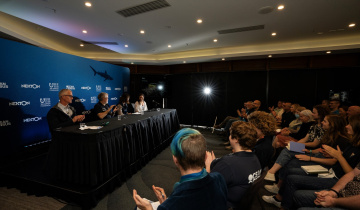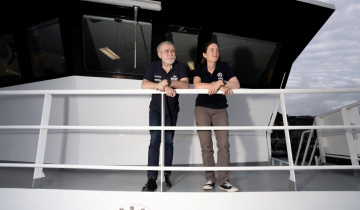NIWA’s research vessel Tangaroa will set sail next week to explore the minerals potential of deep-sea volcanoes of the Kermadec Arc, 200 km north-east of Auckland
NIWA’s research vessel Tangaroa will set sail next week to explore the minerals potential of deep-sea volcanoes of the Kermadec Arc, 200 km north-east of Auckland.
On this trip, the mineral wealth of the Kermadec Arc will be probed and scanned in an attempt to improve our understanding of the size and distribution of the resource, and the vulnerability of the ecosystem to human impacts. The attention is on three submarine volcanoes, the East and West craters of Rumble II, and Brothers Volcano. The volcanoes are rich in iron, manganese, and copper, with lesser concentrations of zinc, lead and gold.
There are potentially large mineral resources within New Zealand’s Exclusive Economic Zone (EEZ). These are particularly associated with these undersea volcanic regions. The voyage has two aims: to decide whether New Zealand scientists can develop better methods for assessing the size and extent of the mineral resource, and improve our knowledge of the animals that live on the seafloor and hence understanding of the environmental impacts of any potential mining.
There is huge economic potential for the resource. But critical questions must be answered. Is the resource worth mining? What are the environmental impacts? Can that mining be done in a way that will minimise the environmental impacts?
“We are providing robust science so informed decisions can be made,” says voyage leader Dr Geoffroy Lamarche of NIWA.
The first leg of the trip, which will take 17 days, focuses on geophysical prospecting of the seafloor, with the aim of characterising massive sulphide deposits that may in future be extractable in an environmentally sustainable way.
The scientists will capture three-dimensional images of volcanoes using seismic equipment. They will map the sub-surface structure of areas that are known to have submarine vents capable of creating valuable mineral deposits. “We are going to do two transects across the Kermadec arc, to Colville arc. These will be the first seismic profiles across the volcanic region,” says Dr Lamarche.
The second leg of the trip, which will take 12 days, looks at the sea-bed biodiversity of the three volcanoes. Sampling will occur in areas identified as having high levels of mineral deposition, as well as where mineral content is low. “This gives us the ability to evaluate the impacts of mining, and whether particularly sensitive animals will be affected,” says Dr Malcolm Clark, who will lead the biology leg.
Many of the arc volcanoes have highly active hydrothermal vent systems, which can have special biological communities comprising animals which are adapted to a very hot and chemically rich environment. The scientists will investigate the composition, distribution, and abundance of the seafloor communities by collecting samples and photographic images from numerous sites on the volcanoes.
This is the first voyage of a 5-year programme funded by the Foundation for Research, Science, and Technology, in collaboration with Auckland University, GNS Science, and Woods Hole Oceanographic Institute in the USA. This program follows a long series of oceanographic voyages undertaken by NIWA and other international research agencies that has led to the discovery of about 40 submarine volcanoes along this 2500 km of volcanic seafloor. This 2500km stretch of volcanic seafloor marks the boundary between the Australian and Pacific tectonic plates.
The biological leg can be followed on the website of the Census of Marine Life programme on Seamounts (http://censeam.niwa.co.nz).









